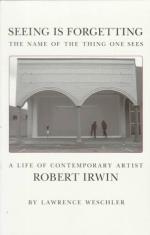
|
| Name: _________________________ | Period: ___________________ |
This test consists of 15 multiple choice questions and 5 short answer questions.
Multiple Choice Questions
1. Later during his disc period, Irwin is able to work with plastic discs, which provide what?
(a) Ease of transport.
(b) A safer work environment.
(c) Weightlessness.
(d) The added element of translucence.
2. What is one major difference between scientist and artist?
(a) A scientist is required to attend college while an artist is not.
(b) A scientist is much more analytical than an artist.
(c) A scientist is not as creative as an artist.
(d) A scientist will keep a record of his failures and successes while an artist just paints over his mistakes until he reaches the desired effect.
3. After gaining understanding of the basics, Irwin does what?
(a) Talks to others about this philosophy.
(b) Creates art inspired by this philosophy.
(c) Gives lectures about this philosophy.
(d) Writes his own view of the philosophy.
4. What three elements are equally positive?
(a) Wall, shadow and disc.
(b) Wall, window, shadow.
(c) Wall, floor, ceiling.
(d) Viewer, window, disc.
5. Critics do not understand the display, referring to it as what?
(a) Beautiful.
(b) A stunt or a nihilistic gesture.
(c) Simple.
(d) A waste of space.
6. The men experiment with ___________________, a device that shuts out all outside distractions, including sound and light.
(a) An anechoic chamber.
(b) An archival chamber.
(c) An arachnid chamber.
(d) An antechamber.
7. Irwin, through his journey of self-discovery, has learned to do what?
(a) Deal with presence with the deductiveness.
(b) Deal with presence without the reductiveness.
(c) Deal with presence with the reductiveness.
(d) Deal with presence without the deductiveness.
8. The passion of Irwin's career has been continually fighting what?
(a) The difficult premise that art is a metaphor of the present.
(b) The difficult premise that art is a metaphor of the world.
(c) The difficult premise that art is a metaphor of the future.
(d) The difficult premise that art is a metaphor of the past.
9. While much thought goes into his writing, it illustrates that his strength in communication lies where?
(a) In the spoken word.
(b) In the written word.
(c) In his art.
(d) In his ability to listen.
10. Irwin is drawn to what?
(a) Los Angeles.
(b) New York.
(c) The desert.
(d) The ocean.
11. What appeals to Irwin regarding these thinkers?
(a) Their level of intelligence and understanding.
(b) The amount of education they have all received.
(c) The inroads made by them in this field.
(d) The commitment made by them and the scale of their ambitions.
12. Irwin is no longer concerned with what?
(a) Being an artist.
(b) The art world context.
(c) His ideas.
(d) Pleasing himself.
13. Researchers in science like Wortz and researchers in art like Irwin have more in common with each other than they do with the technicians in their own fields. Irwin dubs this relationship __________________. T
(a) "The dialogue of collaboration."
(b) "The dialogue of the insane."
(c) "The dialogue of the intelligent."
(d) "The dialogue of immanence."
14. As science comes to what realization, it will come to rely once again on art?
(a) That art is a legitimate field of study.
(b) That artists are intelligent.
(c) That scientists must be creative.
(d) That there is not a logical answer to every question.
15. I think therefore _____________.
(a) I believe.
(b) I am.
(c) I have intelligence.
(d) I matter.
Short Answer Questions
1. Irwin ponders the possibility that the Whitney display may be what?
2. Maurice Tuchman, curator of the Los Angeles County Museum of Art, enlists the cooperation of some __________________ corporate institutions to place artists in an Art and Technology program.
3. He uses vast lighting to feature a project in Berkeley and is disappointed when?
4. This concept is supported by what?
5. How do critics and viewers find the disc displays?
|
This section contains 671 words (approx. 3 pages at 300 words per page) |

|




